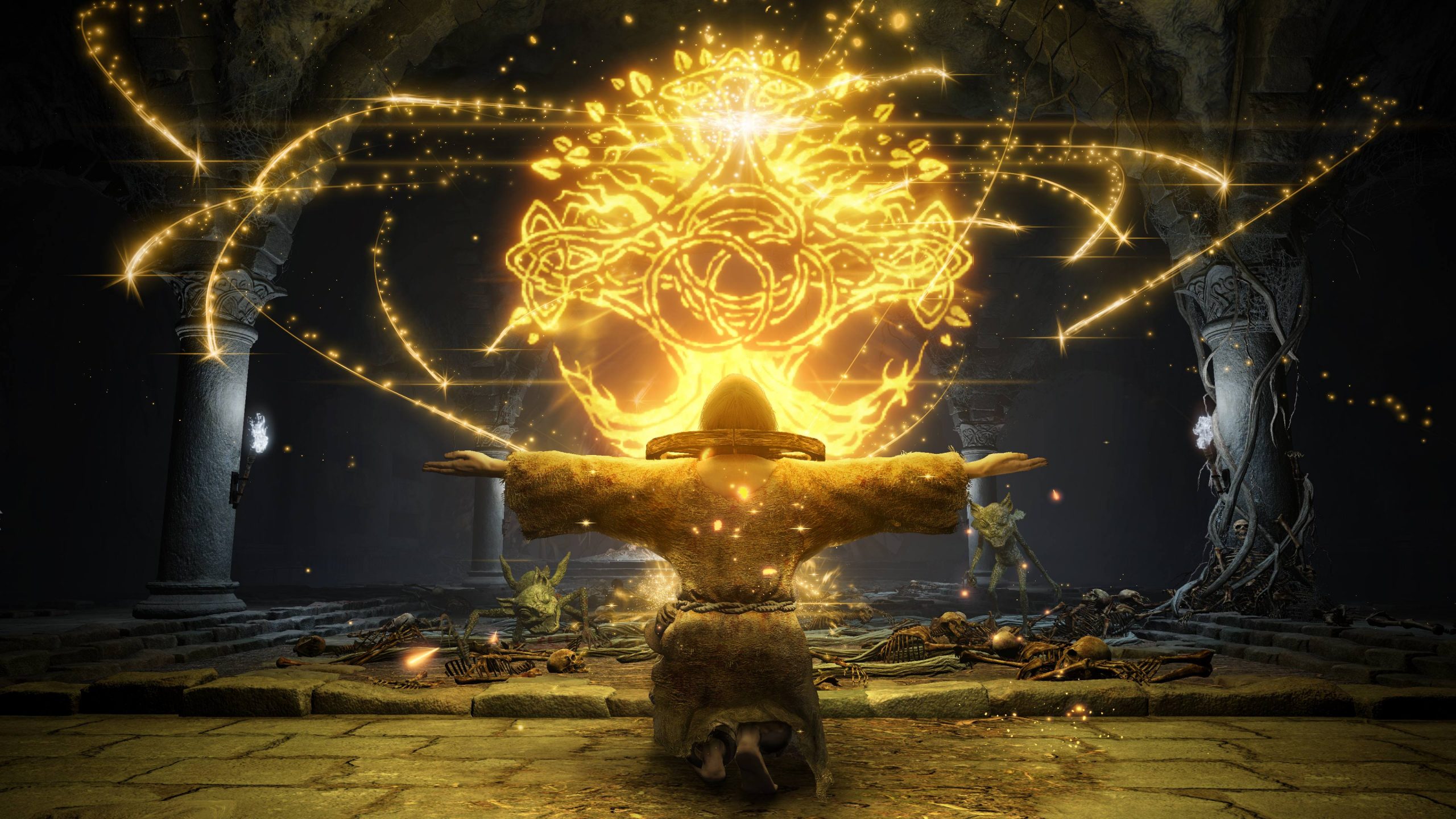
Elden Ring is arguably FromSoftware’s best game to date. The title thrusts players into the Lands Between, a sprawling and beautiful land filled with adventure, treasure, and horrors beyond imagining. And even though FromSoft is set to expand upon the game with some upcoming (and ambitious) DLC, there is still much many gamers don’t know about the base game.
While the Lands Between are full of mysteries, the code that makes up the Elden Ring experience is also laden with secrets. FromSoftware has used game developer magic to craft the game world. Thankfully, you don’t have to study at Raya Lucaria to learn these tricks; you just have to have a keen eye and the ability to slice through game code. Or you could just read this article.
Elden Ring Uses Scrapped Ideas From Previous FromSoftware Games
The first boss of Raya Lucaria (but not a mandatory one) is the Red Wolf of Radagon. This giant…well, red wolf swings around spells, one of which takes the form of a flaming sword. This might sound familiar as the Great Gray Wolf Sif from Dark Souls also fights with a sword in its mouth. However, that might not be the origin of Radagon’s wolf.
The leader of Dark Souls III’s Watchdogs of Farron covenant, the Old Wolf of Farron, was once meant to be a boss in that game, but it was cut during development. Modders dug into the files of both games, noticed more than a few similarities, and concluded that the Old Wolf of Farron’s boss fight was used as the skeleton for the Red Wolf of Radagon. While it’s unlikely Dark Souls III’s wolf could have used magic, the running theory is that its sword attacks were planted into Elden Ring, and the magic attacks were grafted onto it later.
Golden Eyes and Other Secrets Hidden In Plain Sight
FromSoftware’s modelers spent a lot of time turning the physical design of every enemy and NPC into a story. Some design choices are quite obvious, such as the sunken stomachs of many enemies, while others can go unnoticed. For instance, Cemetery Shades aren’t truly undead but are actually controlled by mothlike insects that sit on their heads like crowns. Plus, it’s easy to miss that some giant crayfish carry egg clusters and the occasional parasite, or that the eyes of Flame Chariots track player characters.
One of Elden Ring’s most devious bits of worldbuilding is the “Grace of Gold.” Everyone who isn’t a Tarnished supposedly has some, but this isn’t just some lore – it’s a hidden detail most players will never notice. Virtually every human enemy has at least a blotch of gold in their eye texture. Sometimes the gold blob is so small you can’t see it without combing through game files, other times golden eyes are hidden underneath masks. But if an NPC or enemy is human and non-Tarnished, they’ve got golden eyes.
The Reason For The Polymorphic Bosses
Elden Ring is full of beginner’s traps. The Limgrave Tree Sentinel is probably the most famous example, but most traps are more devious than others. Every now and then, players might come across a seemingly simple enemy that suddenly transforms into a distinctly different creature, usually a miniboss of some kind. On the surface, this metamorphosis has no rhyme or reason other than to give players a heart attack. However, a closer examination of those creatures reveals another theory.
While the enemies that transform (and what they transform into) might seem random, they are all tied together by their loot: a Larval Tear. These items are crucial for anyone who wants to try new stat builds, but they are also the cores of the shapeshifting Silver and Mimic Tears. Given this lore dump – and because a Silver Tear transforms into a Troll in Nokron – the running theory is that these morphing enemies are nothing more than Mimic Tears that found their way to the surface. Powerful Mimic Tears, but Mimic Tears nonetheless.
Ambushes Are Coded Into The Levels
Arguably the best way to fight any enemy in a Soulsborne is to not fight them at all – just sneak up and backstab them. Then again, it’s not uncommon for enemies to use that same trick against you. Ambushes are basically a Soulsborne tradition, but they raise the question of why some enemies have zero peripheral vision while others seemingly see through walls.
It turns out that all enemies in Elden Ring, and by extension all enemies in Soulsborne titles, are controlled by two scripts. The first is their AI, which dictates their behavior (e.g., whether they use magic or not), but the most important is an event script tied to different areas of the game. Whenever a player character enters a specific “event region,” it activates enemies tied to it, essentially waking them up to make them start their routines. This method saves on processing load, but modders have demonstrated that all it takes is one typo to completely detach an NPC from their event region, thus rendering them useless.
Big Enemies Aren’t Just for Intimidation
The Soulsborne (and, by extension, Soulslike) genre is home to many large enemies. Most bosses tower over the player character, and even standard enemies are generally taller than the main character. This is more than just an aesthetic choice.
Popular Soulsborne content creator Zullie the Witch (who has cropped up a lot in this article) theorized this design choice was implemented to help players see enemy attacks more clearly. Larger enemy models mean more intimidating opponents, but it also means more visible and readable attacks since not even the biggest weapons will block the player’s view. And whenever a cutscene plays, the game just swaps out a smaller NPC model to make the size difference less egregious. This design philosophy is not only a core tenet of soulsborne titles but other modern games. Ever wonder why Link is so short in Breath of the Wild/Tears of the Kingdom? This is probably why.
Updates Patched Out More than Just Character Builds
Like many modern games, Elden Ring has been updated with numerous patches. Most of these changes have altered the strength and scaling of items and spells, thus forcing players to update their builds every now and then, but some patch inclusions have been a bit more sneaky. Several patches have altered the locations of certain loot, and a few have even rewrote the lore of the Lands Between.
Arguably the most crucial patch was the first one. In the 1.0 build of Elden Ring, the Lake of Rot and Grand Cloister were populated by special rot-infested Ancestral Followers that aren’t found anywhere else in the game. If you explore these areas in any other build version, you will instead encounter Kindred of Rot. The only way to fight these special Ancestral Followers is to play Elden Ring straight off the disk, offline, and with no patches. And these rotted Followers weren’t the only victim: the same patch swapped the identities of two Crucible Knights.
Enemies Only Sometimes Read Your Inputs
In true soulsborne fashion, every fight in Elden Ring is a delicate balance of attacks and blocking/dodging. And while battles are challenging, they are still fair. Mostly. It turns out anyone who accuses enemies of cheating in the game might have been unintentionally close to the truth.
For an experiment, YouTuber Zullie the Witch slightly modified the AI of one of the game’s most annoying bosses, the Godskin Apostle, and they learned something quite amazing. Turns out whenever a Godskin (and presumably other enemies) isn’t in the middle of an attack animation, it is programmed to watch for different flags associated with specific animations and react accordingly. These include many spells and, you guessed it, using the Flasks of Crimson Tears. However, not everything has a flag (e.g., Raw Meat Dumplings and Night Comet). Moreover, the AI doesn’t care if a spell will hit; if it has a flag, the Godskin reacts in a blind, pre-programmed manner.
Only You Can Dispell Illusory Walls
Illusory walls are a major recurring element in soulsborne titles. They might be placed in some insidious locations, but they only take one hit to dispel. Plus, these walls (usually) hide amazing secrets. But how do they work? The answer is quite simple: Illusory walls are demi-NPCs.
Prior to Patch 1.04, word spread of a particular wall in Volcano Manor boasting an ungodly health pool of 9,999 HP, which meant it required around 50 hits to break. This news made many players wonder what made this wall so special. According to Zullie the Witch, nothing; all illusory walls have 9,999 HP. It’s just that they’re programmed to play a self-deletion event when hit by a player character’s attack. Heck, assuming FromSoft hasn’t patched it out, the “attack” doesn’t have to deal any damage, just have a hitbox.
Many Items Have Unintended Consequences
As previously stated, you can dispel an illusory wall with an “attack” that doesn’t deal any damage because it’s programmed to respond to player hitboxes, not damage output. As a result, Margit’s Shackle and Mohg’s Shackle are perfect wall minesweepers since they have such large hitboxes. The running theory is that they produce intangible explosions but are programmed to only affect Margit and Mohg, respectively. But since invisible walls are on the lookout for hitboxes of any kind, they are inadvertently affected.
These shackles are far from the only items in Elden Ring with unintentional side effects. Wearing the Deathbed Dress used to have some unintended consequences. The “armor” doesn’t provide a ton of defense, it makes up for that with the ability to replenish ally HP. Prior to Patch 1.06, the dress also broke stealth. If you wore it, nearby enemies always knew where you were, even if you were crouched. The running theory was that while the healing aura didn’t do anything to opponents, it was miscoded to alert them. This glitch was patched out, but it still gave players a glimpse into how certain mechanics interacted with the game world.
for the PVP fans and a lone teleporter in the Consecrated Snowfield for PVE players.
FromSoftware Went Crazy With Hiding Some Equipment
While Elden Ring has plenty of loot, you probably won’t be able to find every piece of equipment in one run, and not just because certain quest decisions lock you out of certain items. Some weapons and armor are notoriously difficult to find. We have a guide to help you locate some of the game’s better weapons, but some items are hidden in even more clandestine locations than those.
The Cinqueda is possibly one of the most furiously difficult weapons to find because, unlike other rare weapons, you can’t pick it off an enemy’s corpse. You can only find this dagger if you explore the aforementioned ruins behind the Bestial Sanctum. Even if you do reach this location, the item is easy to miss as it requires you to make several leaps of faith into apparent death just to reach it. The Shield of the Guilty is similarly elusive since it is secured in a chest hidden in a building within Demi-Human Forest Ruins. Which one? Well if it were easy to tell you, the item wouldn’t be so infamously rare, now would it?
A Mount is Only Sometimes a Separate NPC
While mounted enemies are nothing new in Soulsborne games, the ability to ride a steed in Elden Ring is a game changer. Not only can players traverse the open world of the Lands Between much faster, but the system altered how FromSoftware used mounts in the game.
Some mounted enemies, or to be more specific Elden Ring’s most noteworthy mounted enemies, stick to the classic design method of splitting a single NPC between two models. General Radahn is probably the biggest example, figuratively and literally, as he is inseparable from his horse Leonard save for the occasional meteor attack. Regardless, the game is full of NPCs who can mount others and ride them. The most common examples are the Nomadic Merchants, but the Nox ant riders are also separate entities from their six-legged steeds. According to modders, far more NPCs were programed with mounting capabilities than can actually use them in the finished product.
Some Dungeon Traps Are Living Creatures
Whenever players delve into a Hero’s Grave in Elden Ring, they have to contend with more than just lurking monsters. Fireball turrets and guillotines are common sights, but arguably the worst of the worst have to be the giant Chariots. These ambulatory statues run down players and enemies alike and are placed in the most annoying locations, but they aren’t your typical trap.
Unlike virtually every other Hero’s Grave or dungeon obstacle, Chariots are classified as NPCs. They even have an HP pool with a staggering one health. This explains why you can destroy Chariots (with explosive pots you can sometimes drop down on them). However, one mystery remains: why Chariots are mountable. If you hack the game, you can technically ride them. This feat is only possible thanks to the Chariot’s NPC nature, and makes you wonder what FromSoftware had in store for these assets.
The Difference Between Murky Water and a Poison Swamp
Hidetaka Miyazaki’s love of poison swamps is a running gag. He loves this treacherous terrain so much that he invented a different flavor of poison just for Elden Ring: Scarlet Rot. However, many players probably wonder just how FromSoftware’s developers even made all these poison swamps in the first place.
The secret to all of Elden Ring’s poison swamps – and all of the game’s terrain for that matter – is something known as “Hit Material.” While textures give poison swamps and puddles of rot their signature unhealthy glows, Hit Materials tell the game to inflict players with specific status effects whenever they walk over these areas. Hit Materials are also crucial for every other type of hazardous terrain, including lava, and even more mundane lands. Without Hit Materials, Elden Ring’s engine wouldn’t know what kinds of footsteps sounds to use when players walk.
More Mechanics Means More Exploration
In video games, a character’s abilities determines how levels are built and vice versa. For instance, since players couldn’t jump in prior FromSoftware games (Sekiro: Shadows Die Twice notwithstanding), the developers didn’t hide too many secrets behind jumping puzzles. But since you can jump in Elden Ring – and double jump while riding Torrent – the level designers rethought how they could hide secrets.
In Elden Ring, numerous hidden locations and treasure troves are hidden right off cliffs and sheer drops that would spell death in any other soulsborne title. For instance, if you travel behind the Bestial Sanctum, you can drop down onto a series of roots that lead to jutting ruins that house a special early-game talisman and dagger. Level designers applied the same logic to numerous other areas. Some locations even take advantage of the open world design and can be accessed in more than one way. Mohgwyn Palace is probably the most notable example since FromSoft designed two routes that cater to different playstyles: White Mask Varre’s quests for the PVP fans and a lone teleporter in the Consecrated Snowfield for PVE players.
The post Incredible Elden Ring Secrets You Never Knew Existed appeared first on Den of Geek.










